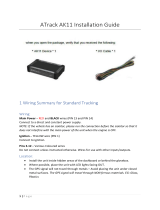
CONTENTS
INSTALLATION............................................................................................1-1
TOP COVER PICTOGRAPH DESCRIPTION...............................................................1-2
UNCRATING PROCEDURE (FOR TYPICAL STEEL FRAME)....................................1-3
MOUNTING THE OUTBOARD MOTOR.......................................................................1-5
MOUNTING THE REMOTE OIL TANK.......................................................................1-10
OUTBOARD MOTOR DIMENSIONS..........................................................................1-12
PROPELLERS..............................................................................................2-1
PROPELLER SPECIFICATIONS..................................................................................2-2
PROPELLER SELECTION...........................................................................................2-5
2009 PROPELLER APPLICATIONS ............................................................................2-5
WOT OPERATION RANGE TABLE ...........................................................................2-11
REMOTE CONTROLS .................................................................................3-1
REMOTE CONTROL APPLICATIONS.........................................................................3-2
REMOTE SWITCH APPLICATIONS ..........................................................................3-15
REMOTE CONTROL CABLES...................................................................................3-24
REMOTE CONTROL ATTACHMENT KIT..................................................................3-26
STEERING HOOK......................................................................................................3-28
STEERING GUIDE ATTACHMENT KIT .....................................................................3-31
CONVENTIONAL WIRE HARNESS...........................................................................3-33
DIGITAL ELECTRONIC CONTROL WIRE HARNESS...............................................3-35
TILLER HANDLES.......................................................................................4-1
6X4 MULTI-FUNCTION TILLER HANDLE ...................................................................4-2
STEERING FRICTION CONTENTS...........................................................................4-11
CONVENTIONAL GAUGE (6Y5 & 6Y7)......................................................5-1
MOUNTING THE METERS ..........................................................................................5-4
ANALOG TACHOMETER.............................................................................................5-5
DIGITAL TACHOMETER..............................................................................................5-7
SPEEDOMETER...........................................................................................................5-9
FUEL MANAGEMENT GAUGE ..................................................................................5-12
ANALOG TRIM METER..............................................................................................5-18
COOLANT PRESSURE METER ................................................................................5-19
COOLANT TEMP. METER .........................................................................................5-20
HOUR METER............................................................................................................5-26
VOLTAGE METER......................................................................................................5-28
FUEL METER .............................................................................................................5-29
CHARGE WARNING UNIT.........................................................................................5-30
WIRE HARNESSES....................................................................................................5-31
WIRING DIAGRAMS...................................................................................................5-35




















